Paper Menu >>
Journal Menu >>
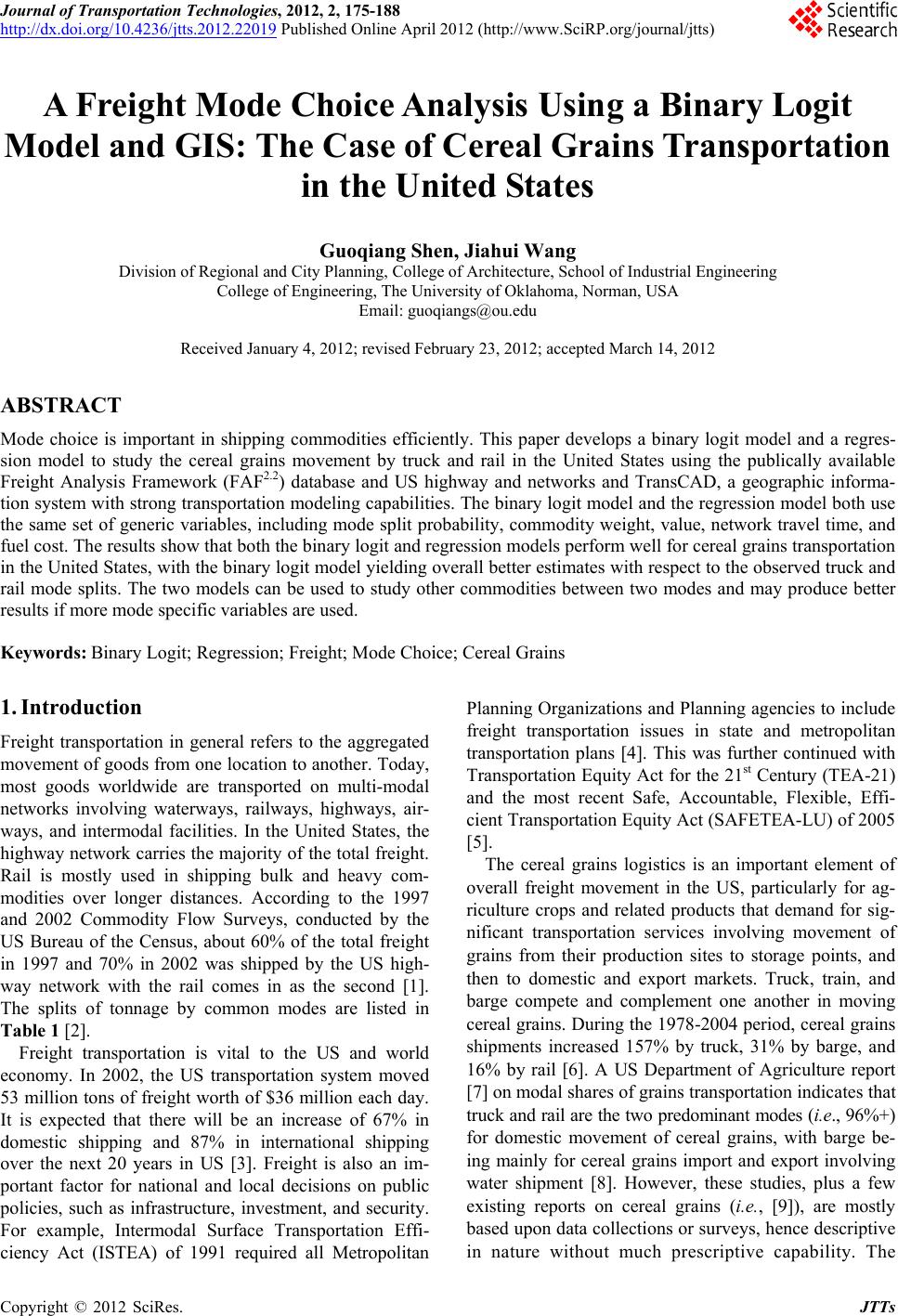 Journal of Transportation Technologies, 2012, 2, 175-188 http://dx.doi.org/10.4236/jtts.2012.22019 Published Online April 2012 (http://www.SciRP.org/journal/jtts) A Freight Mode Choice Analysis Using a Binary Logit Model and GIS: The Case of Cereal Grains Transportation in the United States Guoqiang Shen, Jiahui Wang Division of Regional and City Planning, College of Architecture, School of Industrial Engineering College of Engineering, The University of Oklahoma, Norman, USA Email: guoqiangs@ou.edu Received January 4, 2012; revised February 23, 2012; accepted March 14, 2012 ABSTRACT Mode choice is important in shipping commodities efficiently. This paper develops a binary logit model and a regres- sion model to study the cereal grains movement by truck and rail in the United States using the publically available Freight Analysis Framework (FAF2.2) database and US highway and networks and TransCAD, a geographic informa- tion system with strong transportatio n modeling capabilities. The binary logit model an d the regression model both use the same set of generic variables, including mode split probability, commodity weight, value, network travel time, and fuel cost. The results show th at both th e binary lo git and regression models perform well for cer eal grains transp ortation in the United States, with the binary logit mod el yielding overall better estimates with respect to the observed truck an d rail mode splits. The two models can be used to study other commodities between two modes and may produce better results if more mode specific variables are used. Keywords: Binary Logit; Regression; Freight; Mode Choice; Cereal Grains 1. Introduction Freight transportation in general refers to the aggregated movement of goods from one location to another. Today, most goods worldwide are transported on multi-modal networks involving waterways, railways, highways, air- ways, and intermodal facilities. In the United States, the highway network carries the majo rity of the total freight. Rail is mostly used in shipping bulk and heavy com- modities over longer distances. According to the 1997 and 2002 Commodity Flow Surveys, conducted by the US Bureau of the Census, about 60% of the total freight in 1997 and 70% in 2002 was shipped by the US high- way network with the rail comes in as the second [1]. The splits of tonnage by common modes are listed in Table 1 [2]. Freight transportation is vital to the US and world economy. In 2002, the US transportation system moved 53 million tons of freight worth of $36 million each day. It is expected that there will be an increase of 67% in domestic shipping and 87% in international shipping over the next 20 years in US [3]. Freight is also an im- portant factor for national and local decisions on public policies, such as infrastructure, investment, and security. For example, Intermodal Surface Transportation Effi- ciency Act (ISTEA) of 1991 required all Metropolitan Planning Organizations and Planning agencies to include freight transportation issues in state and metropolitan transportation plans [4]. This was further continued with Transportation Equity Act for the 21st Century (TEA-21) and the most recent Safe, Accountable, Flexible, Effi- cient Transportation Equity Act (SAFETEA-LU) of 200 5 [5]. The cereal grains logistics is an important element of overall freight movement in the US, particularly for ag- riculture crops and related products that demand for sig- nificant transportation services involving movement of grains from their production sites to storage points, and then to domestic and export markets. Truck, train, and barge compete and complement one another in moving cereal grains. During the 1978-2004 period, cereal grains shipments increased 157% by truck, 31% by barge, and 16% by rail [6]. A US Department of Agriculture report [7] on modal shares of grains transportation indicates that truck and rail are the two predominant modes (i.e., 96%+) for domestic movement of cereal grains, with barge be- ing mainly for cereal grains import and export involving water shipment [8]. However, these studies, plus a few existing reports on cereal grains (i.e., [9]), are mostly based upon data collections or surveys, hence descriptive in nature without much prescriptive capability. The C opyright © 2012 SciRes. JTTs 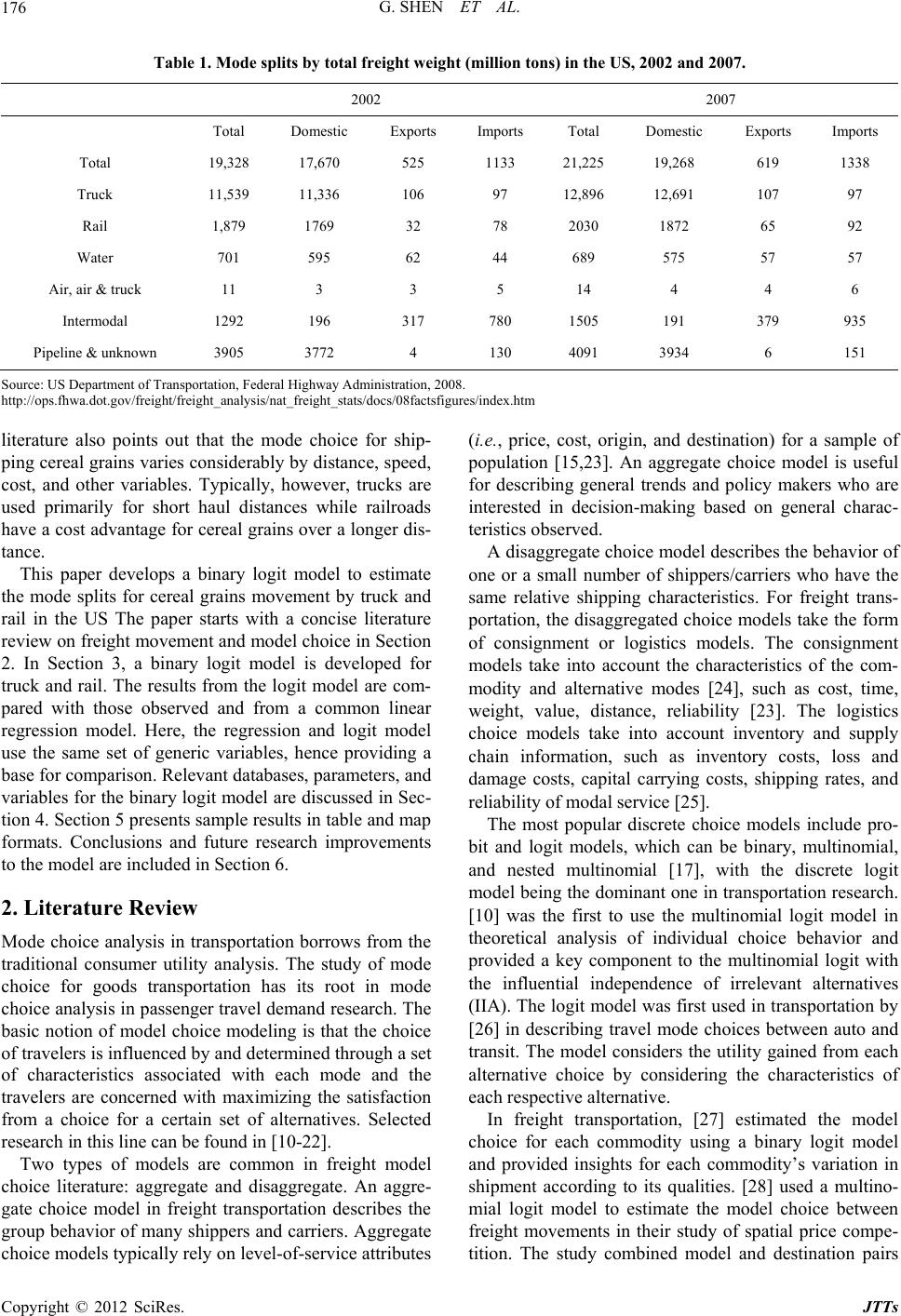 G. SHEN ET AL. 176 Table 1. Mode splits by total freight weight (million tons) in the US, 2002 and 2007. 2002 2007 Total Domestic Exports Imports Total Domestic Exports Imports Total 19,328 17,670 525 1133 21,225 19,268 619 1338 Truck 11,539 11,336 106 97 12,896 12,691 107 97 Rail 1,879 1769 32 78 2030 1872 65 92 Water 701 595 62 44 689 575 57 57 Air, air & truck 11 3 3 5 14 4 4 6 Intermodal 1292 196 317 780 1505 191 379 935 Pipeline & unknown 3905 3772 4 130 4091 3934 6 151 Source: US Department o f Transportation, Federal Highway Administration, 2008. http://ops.fhwa.dot.gov/freight/freight_analysis/nat_freight_stats/docs/08factsfigures/index.htm literature also points out that the mode choice for ship- ping cereal grains varies considerably by distance, speed, cost, and other variables. Typically, however, trucks are used primarily for short haul distances while railroads have a cost advantage for cereal grains over a longer dis- tance. This paper develops a binary logit model to estimate the mode splits for cereal grains movement by truck and rail in the US The paper starts with a concise literature review on freight movement and model choice in Section 2. In Section 3, a binary logit model is developed for truck and rail. The results from the logit model are com- pared with those observed and from a common linear regression model. Here, the regression and logit model use the same set of generic variables, hence providing a base for comparison. Relevant databases, parameters, and variables for the binary logit model are discussed in Sec- tion 4. Section 5 presents sample results in table and map formats. Conclusions and future research improvements to the model are included in Sectio n 6. 2. Literature Review Mode choice analysis in transportation borrows from the traditional consumer utility analysis. The study of mode choice for goods transportation has its root in mode choice analysis in passenger travel demand research. The basic notion of model choice modeling is that the choice of travelers is influenced by and determined through a set of characteristics associated with each mode and the travelers are concerned with maximizing the satisfaction from a choice for a certain set of alternatives. Selected research in this line can be found in [10-22]. Two types of models are common in freight model choice literature: aggregate and disaggregate. An aggre- gate choice model in freight transportation describes the group behavior of many shippers and carriers. Aggregate choice models typically rely on level-o f-service attributes (i.e., price, cost, origin, and destination) for a sample of population [15,23]. An aggregate choice model is useful for describing general trends and policy makers who are interested in decision-making based on general charac- teristics observed. A disaggregate choice model describes the behavior of one or a small number of shippers/carriers who have the same relative shipping characteristics. For freight trans- portation, the disaggregated choice models take the form of consignment or logistics models. The consignment models take into account the characteristics of the com- modity and alternative modes [24], such as cost, time, weight, value, distance, reliability [23]. The logistics choice models take into account inventory and supply chain information, such as inventory costs, loss and damage costs, capital carrying costs, shipping rates, and reliability of modal service [25]. The most popular discrete choice models include pro- bit and logit models, which can be binary, multinomial, and nested multinomial [17], with the discrete logit model being the dominant one in transportation research. [10] was the first to use the multinomial logit model in theoretical analysis of individual choice behavior and provided a key component to the multinomial logit with the influential independence of irrelevant alternatives (IIA). The logit model was first used in transportatio n by [26] in describing travel mode choices between auto and transit. The model considers the utility gained from each alternative choice by considering the characteristics of each respective alternative. In freight transportation, [27] estimated the model choice for each commodity using a binary logit model and provided insights for each commodity’s variation in shipment according to its qualities. [28] used a multino- mial logit model to estimate the model choice between freight movements in their study of spatial price compe- tition. The study combined model and destination pairs Copyright © 2012 SciRes. JTTs 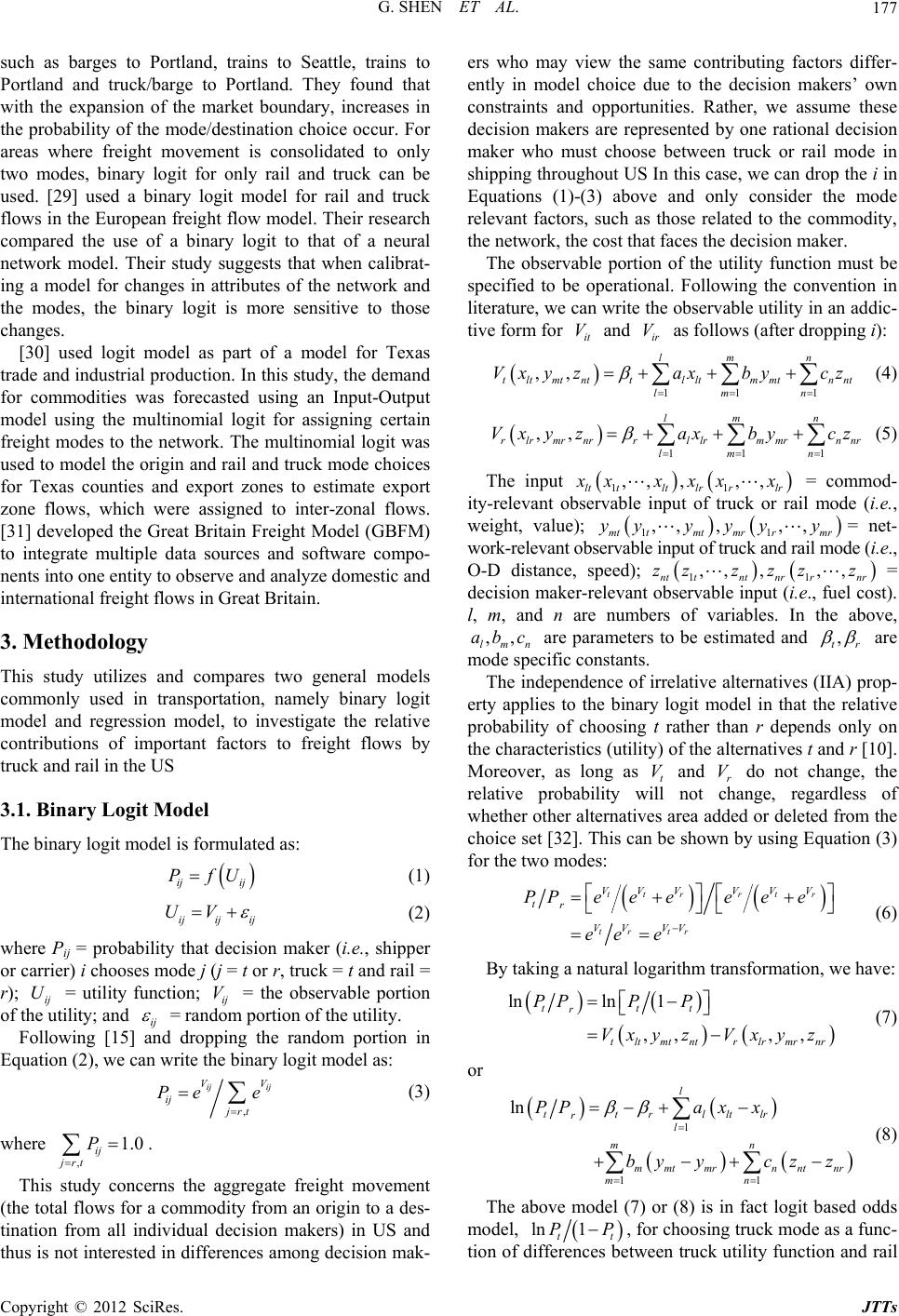 G. SHEN ET AL. 177 such as barges to Portland, trains to Seattle, trains to Portland and truck/barge to Portland. They found that with the expansion of the market boundary, increases in the probability of the mode/destination choice occur. For areas where freight movement is consolidated to only two modes, binary logit for only rail and truck can be used. [29] used a binary logit model for rail and truck flows in the European freight flow model. Their research compared the use of a binary logit to that of a neural network model. Their study suggests that when calibrat- ing a model for changes in attributes of the network and the modes, the binary logit is more sensitive to those changes. [30] used logit model as part of a model for Texas trade and industrial production. In this study, the demand for commodities was forecasted using an Input-Output model using the multinomial logit for assigning certain freight modes to the network. The multinomial logit was used to model the origin and rail and truck mode choices for Texas counties and export zones to estimate export zone flows, which were assigned to inter-zonal flows. [31] developed the Great Britain Freight Model (GBFM) to integrate multiple data sources and software compo- nents into one entity to observe and analyze d omestic and international freight flows in Great Britain. 3. Methodology This study utilizes and compares two general models commonly used in transportation, namely binary logit model and regression model, to investigate the relative contributions of important factors to freight flows by truck and rail in the US 3.1. Binary Logit Model The binary logit model is formulated as: ij ij P fU (1) ijij ij UV (2) where Pij = probability that decision maker (i.e., shipper or carrier) i chooses mode j (j = t or r, truck = t and rail = r); ij = utility function; ij = the observable portion of the utility; and U V ij = rando m portion of the utility. Following [15] and dropping the random portion in Equation (2), we can write the binary logit model as: , ij ij V ij jrt Pe e V (3) where . ,1.0 ij jrt P This study concerns the aggregate freight movement (the total flows for a commodity from an origin to a des- tination from all individual decision makers) in US and thus is not interested in differences among decision mak- ers who may view the same contributing factors differ- ently in model choice due to the decision makers’ own constraints and opportunities. Rather, we assume these decision makers are represented by one rational decision maker who must choose between truck or rail mode in shipping throughout US In this case, we can drop the i in Equations (1)-(3) above and only consider the mode relevant factors, such as those related to the commodity, the network, the cost that faces the decision maker. The observable portion of the utility function must be specified to be operational. Following the convention in literature, we can write the observable utility in an ad dic- tive form for and as follow s (a ft er dr o pping i): it Vir V 11 1 ,, lm n tltmtnt tlltmmtnnt lm n Vxy zaxbycz (4) 11 1 ,, lm n rlrmrnr rllrmmrnnr lm n Vxy zaxbycz (5) The input 11 ,, ,,, lt tltlr rlr x xxxxx = commod- ity-relevant observable input of truck or rail mode (i.e., weight, value); 1 ,, ,, mt tmtmr r 1mr , y yyyyy= net- work-relevant observable input of truck and rai l mode (i.e., O-D distance, speed); ,, , nt tntnr z z 11r nr zz = decision maker-relevant observable input (i.e., fuel co st). l, m, and n are numbers of variables. In the above, are parameters to be estimated and ,z , t ,z r ,, lmn ab c are mode specific constants. The independence of irrelative alternatives (IIA) prop- erty applies to the binary logit model in that the relative probability of choosing t rather than r depends only on the characteristics (utility) of the alternatives t and r [10]. Moreover, as long as and do not change, the relative probability will not change, regardless of whether other alternatives area added or deleted from the choice set [32]. This can be shown by using Equation (3) for the two modes: t Vr V tt t rr r ttr r VV V VV V tr VVV V PPe eeeee ee e (6) By taking a natural logarithm transformation, we have: lnln 1 ,, ,, ttt r tltmtnt rlrmrnr PPP P Vxy zVxyz (7) or 1 11 ln l ttrl ltlr rl mn mmtmrn ntnr mn PPa xx byyczz (8) The above model (7) or (8) is in fact logit based odds model, ln 1 tt , for choosing truck mode as a func- tion of differences between truck utility functio n and rail PP Copyright © 2012 SciRes. JTTs 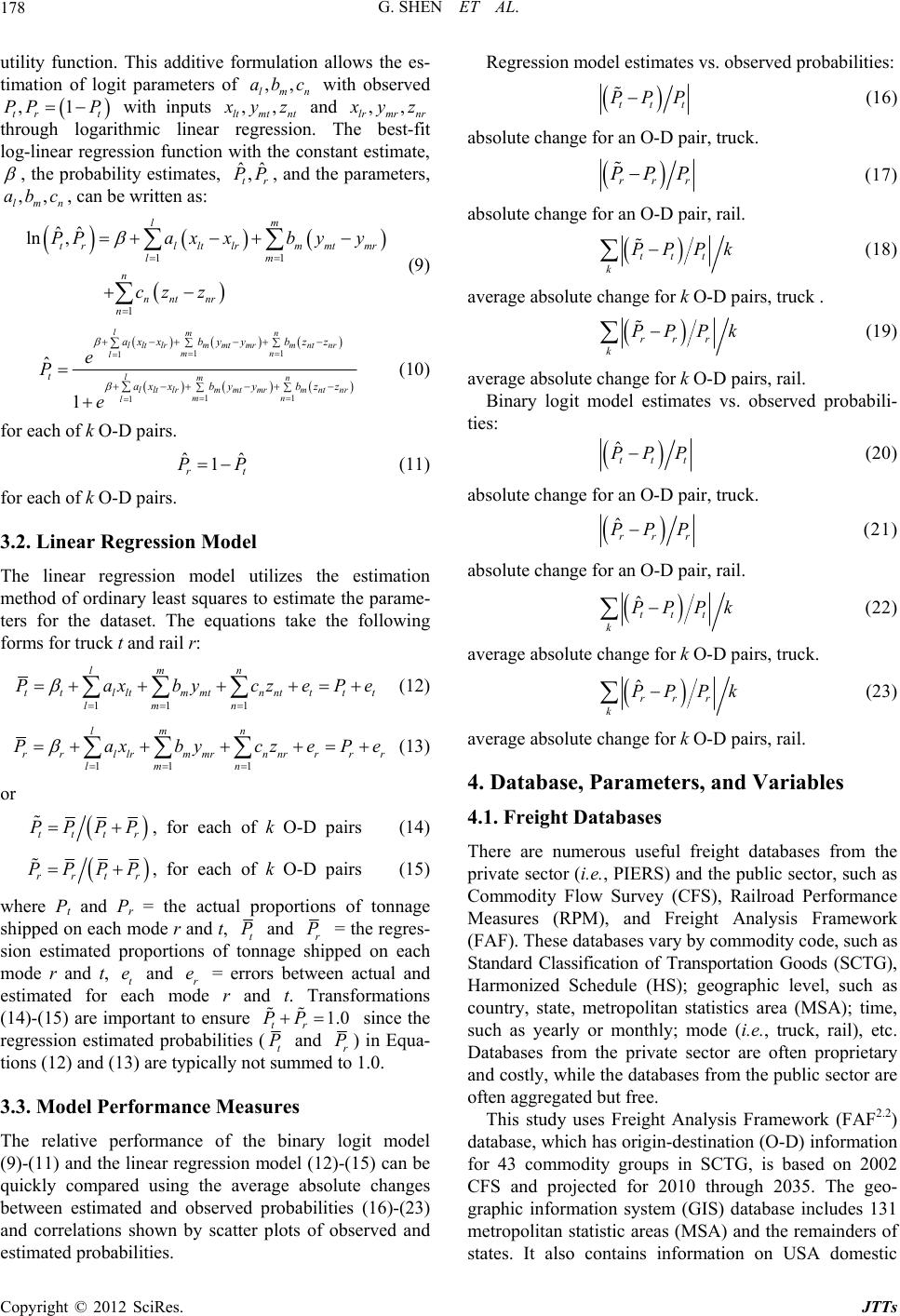 G. SHEN ET AL. 178 utility function. This additive formulation allows the es- timation of logit parameters of with observed with inputs ltmt nt ,, lmn ab c ,, ,1 tr t PP P x yz and ,, lrmr nr x yz through logarithmic linear regression. The best-fit log-linear regression function with the constant estimate, , the probability estimates, , and the parameters, , can be written as: ˆ 1 lr nr x ˆ , tr PP lm m lm b ,, lmn ab c ˆˆ ln , t r n PP 1 l ltmt n nnt a xy czz 1 mr y (9) 11 11 mn mr mnt mn mtmrm mn ybz y b ˆ t P 1 ˆ 1 l l te P e 1 ll t lrmnr ln lltlrnt l ax xbz ax xbz mt m m y y nr z (10) for each of k O-D pairs. ˆ 1 r P (11) for each of k O-D pairs. 3.2. Linear Regression Model The linear regression model utilizes the estimation method of ordinary least squares to estimate the parame- ters for the dataset. The equations take the following forms for truck t and rail r: 11 lm t llt m lm Paxb 1 n nntt n cz t mt ytt ePe (12) 11 lm r rllrm lm Pax 1 n nnrr n cz mr byrr ePe (13) or tttr PPPP , for each of k O-D pairs (14) rrtr P PPP , for each of k O-D pairs (15) where Pt and Pr = the actual proportions of tonnage shipped on each mode r and t, t P and r P tr PP = the regres- sion estimated proportions of tonnage shipped on each mode r and t, and = errors between actual and estimated for each mode r and t. Transformations (14)-(15) are important to ensure since the regression estimated probabilities ( t er e 1.0 t P and r P) in Equa- tions (12) and (1 3) are typically not summed to 1.0. 3.3. Model Performance Measures The relative performance of the binary logit model (9)-(11) an d the linear regression model (12)-(15 ) can be quickly compared using the average absolute changes between estimated and observed probabilities (16)-(23) and correlations shown by scatter plots of observed and Regression model esti mated probabilities. mates vs. observed probabilities: esti ttt PPP (16) absolute change fo r an O-D pair, truck. rrr P PP (17) absolute change fo r an O-D pair, rail. ttt k PPPk (18) average absolute change for k O-D pairs, truck . rrr k PPPk (19) average absolute change for k O-D pairs, rail. probabili- tieBinary logit model estimates vs. observed s: ˆttt PPP (20) absolute change fo r an O-D pair, truck. ˆ PPP rrr (21) absolute change for an O-D pair, rail . ˆ PPPk ttt k (22) average absolute change for k O-D pairs, truck. ˆ PPPk rrr k (23) average absolute change for k O-D pairs, rail. 4. Database, Parameters, and Variables freight databases from the Analysis Framework (FAF) da states. It also contains information on USA domestic 4.1. Freight Databases There are numerous useful private sector (i.e., PIERS) and the pub lic sector, such as Commodity Flow Survey (CFS), Railroad Performance Measures (RPM), and Freight Analysis Framework (FAF). These databases vary by commodity code, such as Standard Classification of Transportation Goods (SCTG), Harmonized Schedule (HS); geographic level, such as country, state, metropolitan statistics area (MSA); time, such as yearly or monthly; mode (i.e., truck, rail), etc. Databases from the private sector are often proprietary and costly, while the databases fro m the public sector are often aggregat ed but free. This study uses Freight 2.2 tabase, which has origin-d estination (O-D) in formation for 43 commodity groups in SCTG, is based on 2002 CFS and projected for 2010 through 2035. The geo- graphic information system (GIS) database includes 131 metropolitan statistic areas (MSA) and the remainders of Copyright © 2012 SciRes. JTTs 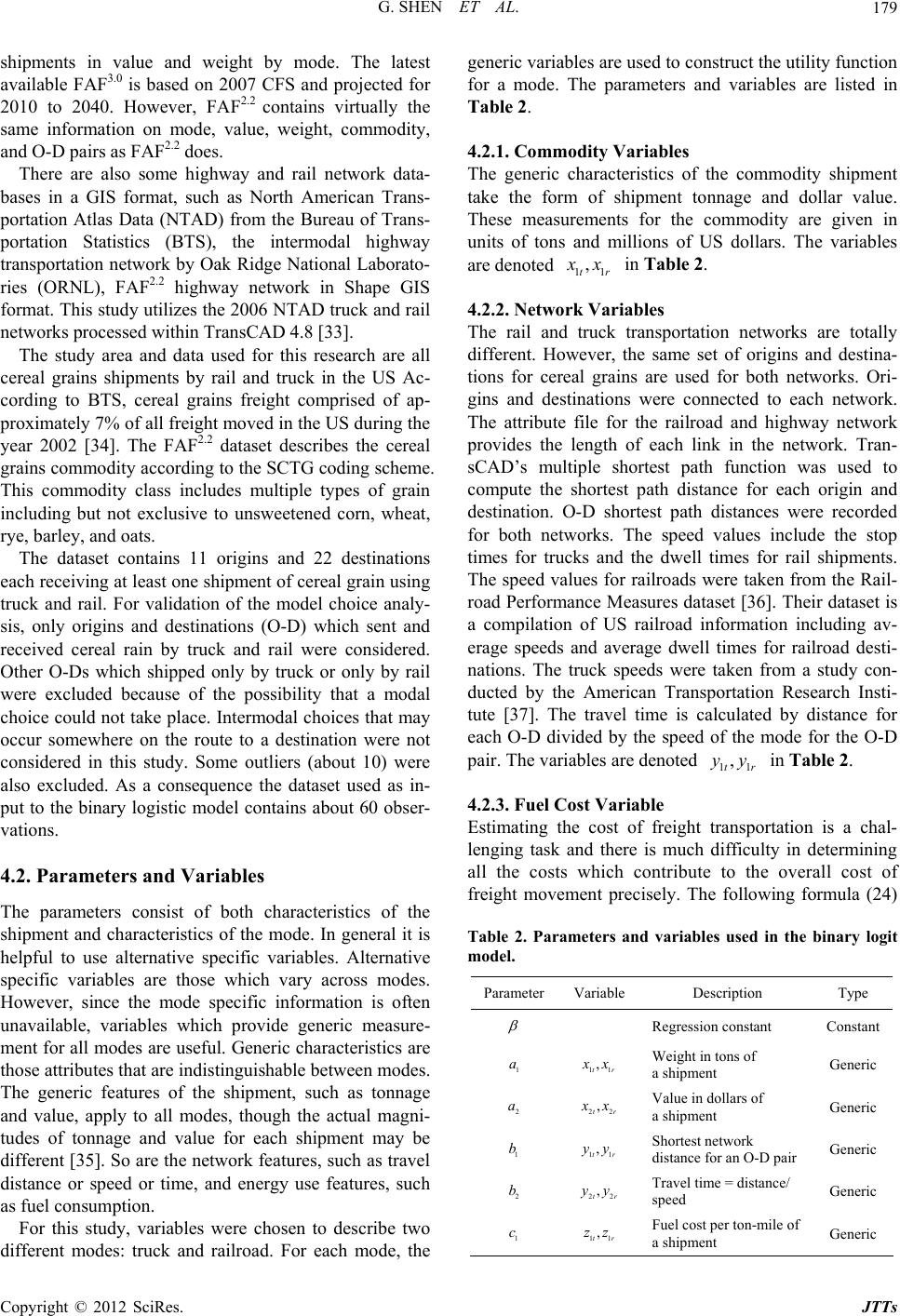 G. SHEN ET AL. 179 shipments in value and weight by mode. The latest available FAF3.0 is based on 2007 CFS and projected for 2010 to 2040. However, FAF2.2 contains virtually the same information on mode, value, weight, commodity, and O-D pairs as FAF2.2 does. There are also some highway and rail network data- bases in a GIS format, such as North American Trans- po US Ac- co one shipment of cereal grain using tru ameters and Variables aracteristics of the ode. In general it is and railroad. For each mode, the ge odity Variables The generic characteristics of the commodity shipment onnage and dollar value. rtation Atlas Data (NTAD) from the Bureau of Trans- portation Statistics (BTS), the intermodal highway transportation netwo rk by Oak Ridge Nation al Laborato- ries (ORNL), FAF2.2 highway network in Shape GIS format. This study utilizes the 2006 NTAD truck and rail networks proce ssed wi t hi n TransC A D 4. 8 [3 3]. The study area and data used for this research are all cereal grains shipments by rail and truck in the rding to BTS, cereal grains freight comprised of ap- proximately 7% of all freigh t moved in the US dur ing the year 2002 [34]. The FAF2.2 dataset describes the cereal grains commodity according to the SCTG coding scheme. This commodity class includes multiple types of grain including but not exclusive to unsweetened corn, wheat, rye, barley, and oats . The dataset contains 11 origins and 22 destinations each receiving at least ck and rail. For validation of the model choice analy- sis, only origins and destinations (O-D) which sent and received cereal rain by truck and rail were considered. Other O-Ds which shipped only by truck or only by rail were excluded because of the possibility that a modal choice could not take place. Intermodal choices that may occur somewhere on the route to a destination were not considered in this study. Some outliers (about 10) were also excluded. As a consequence the dataset used as in- put to the binary logistic model contains about 60 obser- vations. 4.2. Par The parameters consist of both ch shipment and characteristics of the m helpful to use alternative specific variables. Alternative specific variables are those which vary across modes. However, since the mode specific information is often unavailable, variables which provide generic measure- ment for all modes are useful. Generic characteristics are those attributes that are indistinguishable between modes. The generic features of the shipment, such as tonnage and value, apply to all modes, though the actual magni- tudes of tonnage and value for each shipment may be different [35]. So are the network features, such as travel distance or speed or time, and energy use features, such as fuel consumption. For this study, variables were chosen to describe two different modes: truck neric variables are used to construct the utility function for a mode. The parameters and variables are listed in Table 2. 4.2.1. Comm take the form of shipment t These measurements for the commodity are given in units of tons and millions of US dollars. The variables are denoted 11 , tr x x in Table 2. 4.2.2. Netw oriables rk Va The rail and truck transportation networks are totally e set of origins and destina- Estimating the cost of freight transportation is a chal- uch difficulty in determining odel. different. However, the sam tions for cereal grains are used for both networks. Ori- gins and destinations were connected to each network. The attribute file for the railroad and highway network provides the length of each link in the network. Tran- sCAD’s multiple shortest path function was used to compute the shortest path distance for each origin and destination. O-D shortest path distances were recorded for both networks. The speed values include the stop times for trucks and the dwell times for rail shipments. The speed values for railroads were taken from the Rail- road Performance Measures dataset [36]. Their dataset is a compilation of US railroad information including av- erage speeds and average dwell times for railroad desti- nations. The truck speeds were taken from a study con- ducted by the American Transportation Research Insti- tute [37]. The travel time is calculated by distance for each O-D divided by the speed of the mode for the O-D pair. The variables are denoted 11 , tr yy in Table 2. 4.2.3. Fuel Cost Variable lenging task and there is m all the costs which contribute to the overall cost of freight movement precisely. The following formula (24) Table 2. Parameters and variables used in the binary logit m ParameterVariable Description Type Regression Constantconstant 1 a 11 , tr x x Weight in tons of a shipment Generic 2 a 22 , tr x x Value in dollars of a shipment Generic 1 b 11 , tr yy Shortest network distance for an O-D pair ce/ ent Generic 2 b 22 , tr yy Travel time = distan speed Generic 1 c 11 , tr zz Fuel cost per ton-mile of a shipmGeneric Copyright © 2012 SciRes. JTTs 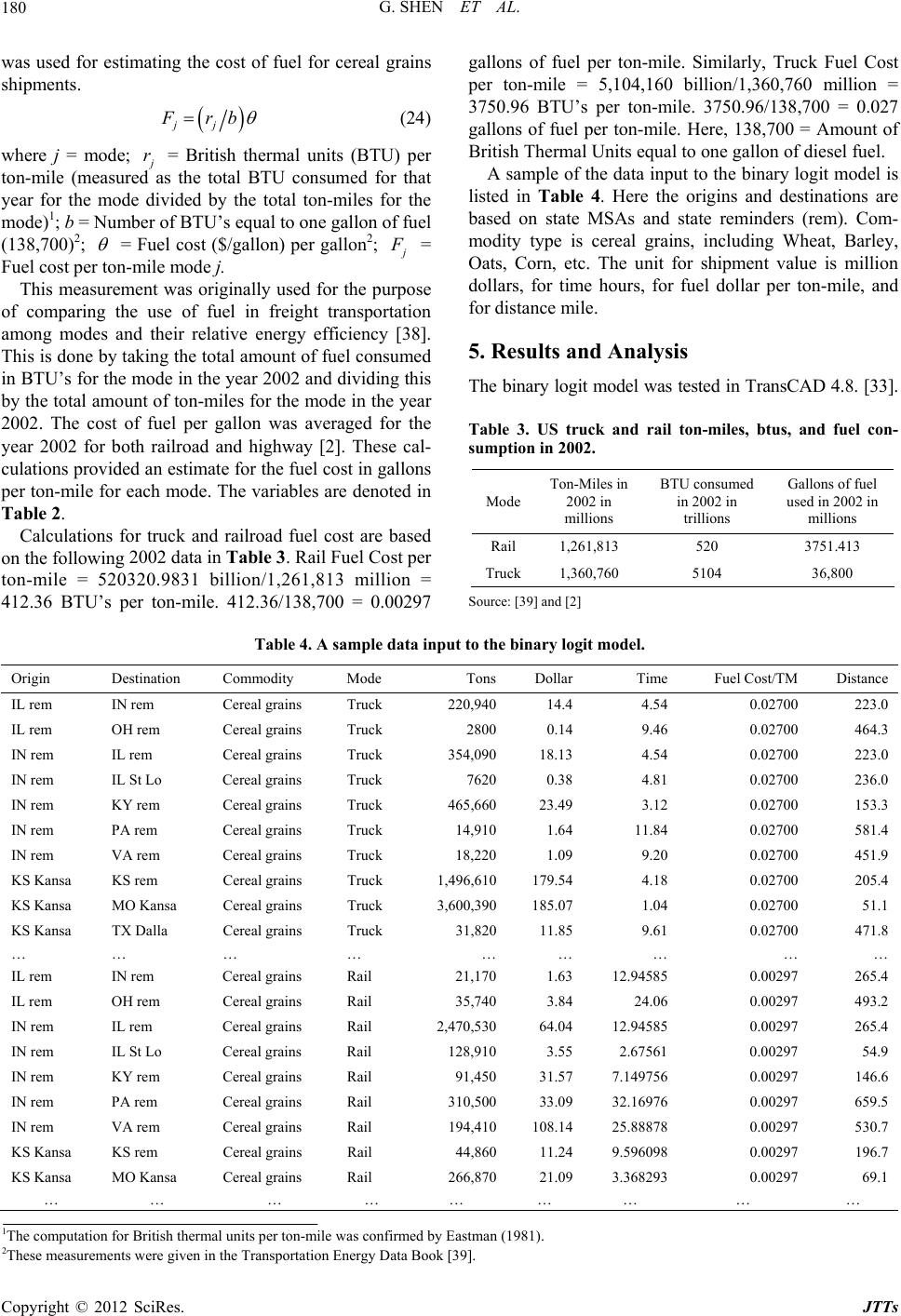 G. SHEN ET AL. Copyright © 2012 SciRes. JTTs 180 was used for estimating ers shipme gallons of fuel per ton-mile. Similarly, Truck Fuel Cost per ton-mile = 5,104,160 billion/1,360,760 million = 3750.96 BTU’s per ton-mile. 3750.96/138,700 = 0.027 gallons of fuel per ton-mile. Here, 138,700 = Amount of British Thermal Units equal to one gallon of diesel fuel. the cost of fuel for ceal grain nts. jj F rb (24) where j = mode; j r red as th di = British th ton-mile (measue total BTU con ermal units (BTU) per sumed for that A sample of the data input to the binary logit model is listed in Table 4. Here the origins and destinations are based on state MSAs and state reminders (rem). Com- modity type is cereal grains, including Wheat, Barley, Oats, Corn, etc. The unit for shipment value is million dollars, for time hours, for fuel dollar per ton-mile, and for distance mile. year for the mode vided by the total ton-miles for the mode)1; b = Number of BTU’s equal to one gallon of fuel (138,700)2; = Fuel cost ($/gallon) per gallon2; j F = Fuel cost per ton-mile mode j. This measrement was originally used for the puose of comparing the use of fuel u rp in freight transportation am 2002 data in Table 3. Rail Fuel Cost per to ong modes and their relative energy efficiency [38]. This is done by taking the total amount of fuel consumed in BTU’s for the mode in the year 2002 and dividing this by the total amount of ton-miles for the mode in the year 2002. The cost of fuel per gallon was averaged for the year 2002 for both railroad and highway [2]. These cal- culations provided an estimate for the fuel co st in gallons per ton-mile for each mode. The variables are denoted in Table 2. Calculations for truck and railroad fuel cost are based on the following 5. Results and Analysis The binary logit model was tested in TransCAD 4.8. [33]. Table 3. US truck and rail ton-miles, btus, and fuel con- sumption in 2002. Mode Ton-Miles in 2002 in millions BTU consumed in 2002 in trillions Gallons of fuel used in 2002 in millions Rail 1,261,813 520 3751.413 Truck1,360,760 5104 36,800 n-mile = 520320.9831 billion/1,261,813 million = 412.36 BTU’s per ton-mile. 412.36/138,700 = 0.00297 Source: [39] and [2] Table 4. A sample data input to the binary logit model. Origin Destination Commodity Mode Tons Dollar Time Fuel Cost/TM Distance IL rem IN rem Cereal grains Truck 220,94014.44.540.02700 2 23.0 IL rem OH rem Cereal grains 1 1 1 a 1,417 a a 3,618 12.9 em rem eal grains 35,73.24.0.00249 2,4 6 1 2. 3 36 1 1 a a a … … Truck 28000.149.460.02700 4 64.3 IN rem IL rem Cereal grains Truck 354,0908.134.540.02700 223.0 IN rem IL St Lo Cereal grains Truck 76200.384.810.02700 236.0 IN rem KY rem Cereal grains Truck 465,66023.493.120.02700 153.3 IN rem PA rem Cereal grains Truck 4,9101.641.840 .02700 581.4 IN rem VA rem Cereal grains Truck 18, 2201.099.200.02700 451.9 KS KansKS rem Cereal grains Truck 96,6109.544.180.02700 205.4 KS KansMO KansCereal grains Truck 00,3905.071.040.02700 51.1 KS Kansa TX DallaCereal grains Truck 31,82011.859.610.02700 471.8 … … … … ………… … IL rem IN rem Cereal grains Rail 21,1701.6345850.00297 265. 4 IL rOH CerRail40840697 3.2 IN rem IL rem Cereal grains Rail 70,5304.0412.945850.00297 265.4 IN rem IL St Lo Cereal grains Rail 28,9103.55675610.00297 54.9 IN rem KY rem Cereal grains Rail 91,45031.577.1497560.00297 146.6 IN rem PA rem Cereal grains Rail 310,5003.092.169 760.00297 59.5 IN rem VA rem Cereal grains Rail 94,41008.1425.888780.00297 530.7 KS KansKS rem Cereal grains Rail 44,86011.249.5960980 .00297 196.7 KS KansMO KansCereal grains Rail 266,87021.093.3682930 .00297 69.1 … …… …… … … 1The computation for British thermal units per ton-mile was confirmed by Eastman (1981). 2These measurements were given in t he Transportation Ener gy Data Book [39]. 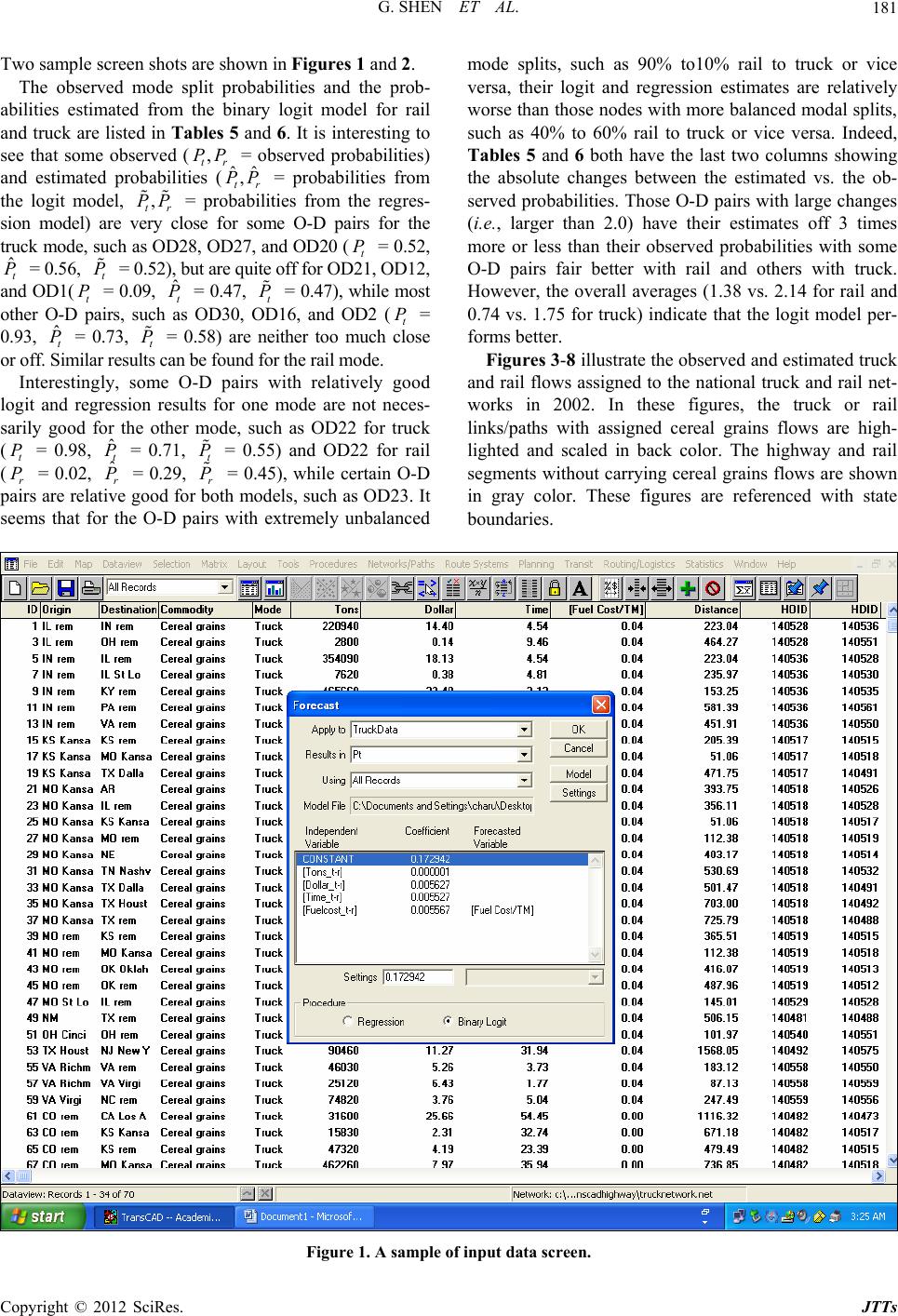 G. SHEN ET AL. 181 Tle screen shots are gure nd 2. Thbserved m split probaties and prob- l e m tir e spuch to10% ruck or ersa, thlogit angression eates are relatively wo sampshown in Fis 1 a e oodebilithe abilities estimated from the binary logit model for rai an Tables 56d truck are listed in and . It is interesting to see that some observed (, tr PP = observed probabilities) and estimated probabilities (ˆˆ , tr PP = probabilities from the logit model, , tr PP = probabilities from the regres- sion model) are very close for some O-D pairs for the truck mode, such as OD28, OD27, and OD20 (t P = 0.52, ˆt P = 0.56, t P = 0.52), but are quite off for OD21, OD12, and OD1(t P = 0.09, ˆt P = 0.47, t P = 0.47), while most oher O-D pairs, such as OD30, OD16, and OD2 (t P = 0.93, ˆt P = 0.73, t P = 0.58) are neither too much close or off. Similar results can be found for the rail mode. Interstingly, soe O-D pairs with relatively good logit and regression results for one mode are not neces- sar t ily good for the other mode, such as OD22 for truck (t P = 0.98, ˆt P = 0.71, t P = 0.55) and OD22 for rail (r P = 0.02, ˆr P = 0.29, r P = 0.45), while certain O-D airs are relative goo opd forth models, such as OD23. It h s b seems that fore O-D pa with extremely unbalanced modlits, s as 90%ail to tr vice veir d restim worse than those nodes with more balanced modal splits, such as 40% to 60% rail to truck or vice versa. Indeed, Tables 5 and 6 both have the last two columns showing the absolute changes between the estimated vs. the ob- served probabilities. Those O-D pairs with large changes (i.e., larger than 2.0) have their estimates off 3 times more or less than their observed probabilities with some O-D pairs fair better with rail and others with truck. However, the overall averages (1.38 vs. 2.14 for rail and 0.74 vs. 1.75 for truck) indicate that the logit model per- forms better. Figures 3-8 illustrate the observed and estimated tru ck and rail flows assigned to the national truck and rail net- works in 2002. In these figures, the truck or rail links/paths with assigned cereal grains flows are high- lighted and scaled in back color. The highway and rail segments without carrying cereal grains flows are shown in gray color. These figures are referenced with state boundaries. Figure 1. A sample of input data screen. Copyright © 2012 SciRes. JTTs 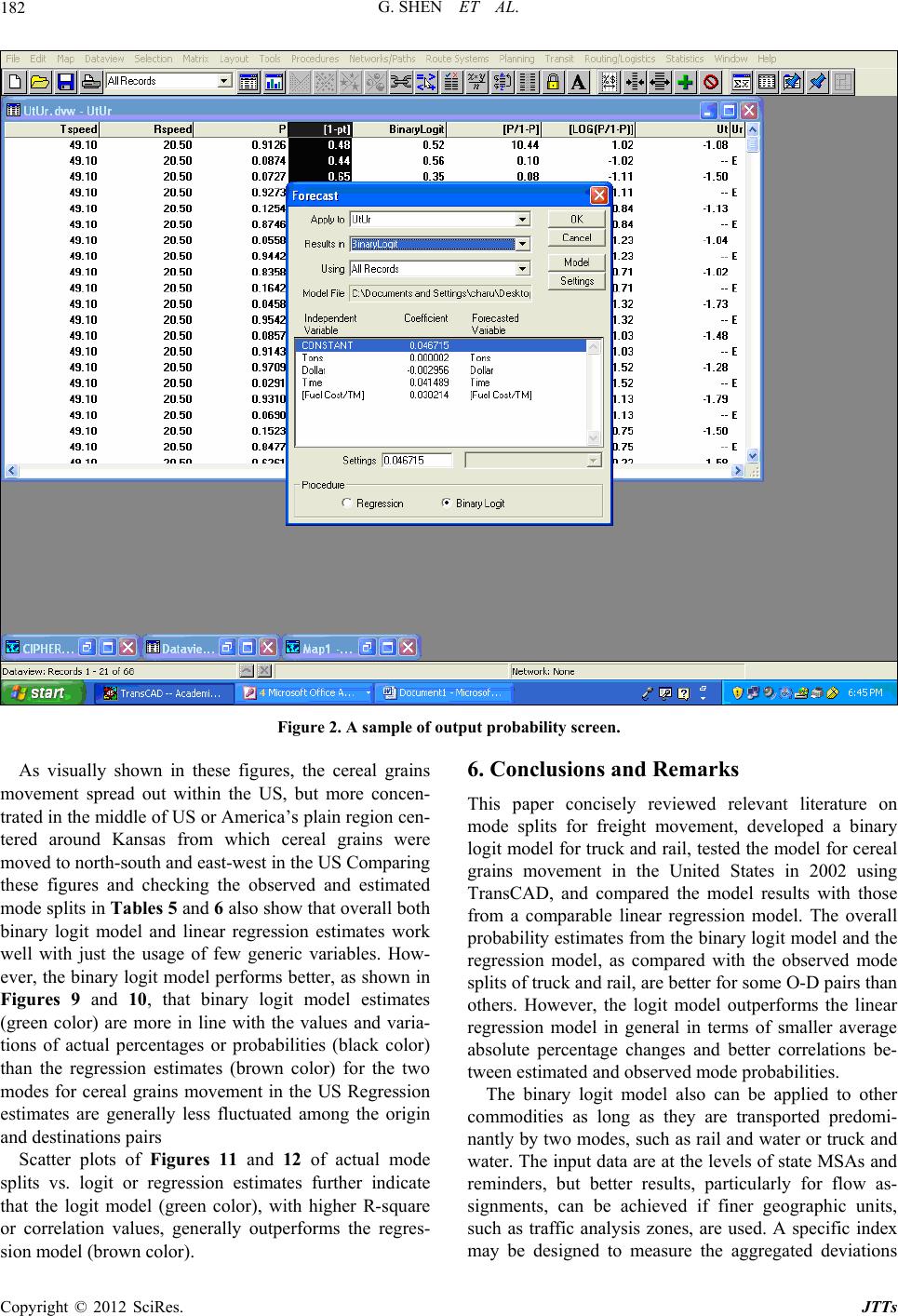 G. SHEN ET AL. 182 Figure 2. A sample of output probability screen. As visually shown in these figures, the cereal grains movement spread out within the US, but more concen- trated in the middle of US or America’s plain region cen- tered around Kansas from which cereal grains were moved to north-south and east-we st in the US Comparing these figures and checking the observed and estimated mode splits in Tables 5 and 6 also show that overall both binary logit model and linear regression estimates work well with just the usage of few generic variables. How- ever, the binary logit model performs better, as shown in Figures 9 and 10, that binary logit model estimates (green color) are more in line with the values and varia- tions of actual percentages or probabilities (black color) than the regression estimates (brown color) for the two modes for cereal grains movement in the US Regression estimates are generally less fluctuated among the origin and destinations pairs Scatter plots of Figures 11 and 12 of actual mode splits vs. logit or regression estimates further indicate that the logit model (green color), with higher R-square or correlation values, generally outperforms the regres- sion model (brown color). 6. Conclusions and Remarks This paper concisely reviewed relevant literature on mode splits for freight movement, developed a binary logit model for truck and rail, tested the model for cereal grains movement in the United States in 2002 using TransCAD, and compared the model results with those from a comparable linear regression model. The overall probability estimates from the binary logit mod el and the regression model, as compared with the observed mode splits of truck and rail, are better for some O-D pairs than others. However, the logit model outperforms the linear regression model in general in terms of smaller average absolute percentage changes and better correlations be- tween estimated and ob served mode probabilities. The binary logit model also can be applied to other commodities as long as they are transported predomi- nantly by two modes, such as rail and water or truck and water. The input data are at the lev els of state MSAs and reminders, but better results, particularly for flow as- signments, can be achieved if finer geographic units, such as traffic analysis zones, are used. A specific index may be designed to measure the aggregated deviations Copyright © 2012 SciRes. JTTs 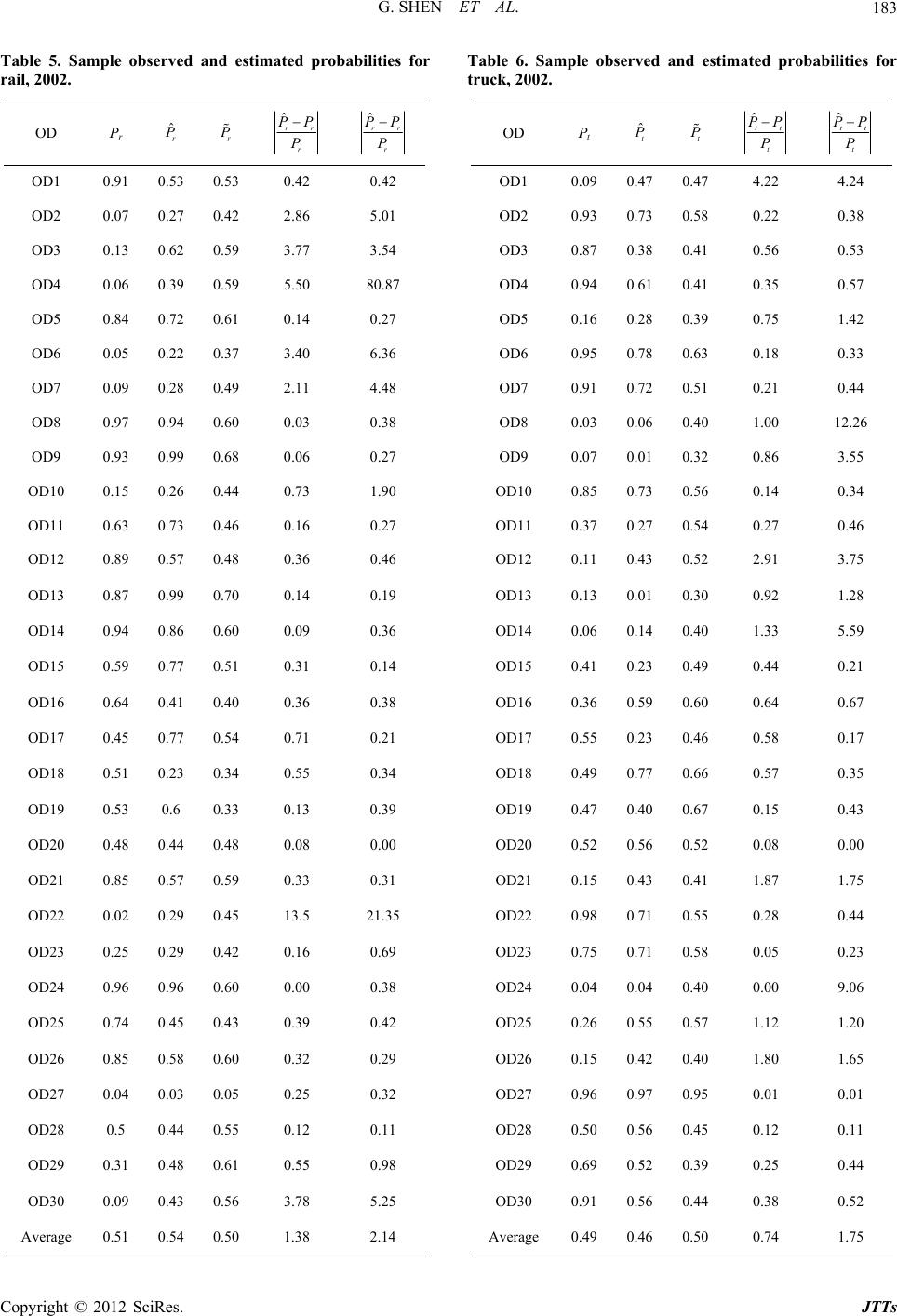 G. SHEN ET AL. 183 Table 6. Sample observed and estimated probabilities for truck, 2002. OD Pt Table 5. Sample observed and estimated probabilities for rail, 2002. OD Pr ˆr P r P ˆrr r PP P ˆrr r PP P OD1 0.91 0.53 0.53 0.42 0.42 OD2 0.07 0.27 0.42 2.86 5.01 OD3 0.13 0.62 0.59 3.77 3.54 OD4 0.06 0.39 0.59 5.50 80.87 OD5 0.84 0.72 0.61 0.14 0.27 OD6 0.05 0.22 0.37 3.40 6.36 OD7 0.09 0.28 0.49 2.11 4.48 OD8 0.97 0.94 0.60 0.03 0.38 OD9 0.93 0.99 0.68 0.06 0.27 OD10 0.15 0.26 0.44 0.73 1.90 OD11 0.63 0.73 0.46 0.16 0.27 OD12 0.89 0.57 0.48 0.36 0.46 OD13 0.87 0.99 0.70 0.14 0.19 OD14 0.94 0.86 0.60 0.09 0.36 OD15 0.59 0.77 0.51 0.31 0.14 OD16 0.64 0.41 0.40 0.36 0.38 OD17 0.45 0.77 0.54 0.71 0.21 OD18 0.51 0.23 0.34 0.55 0.34 OD19 0.53 0.6 0.33 0.13 0.39 OD20 0.48 0.44 0.48 0.08 0.00 OD21 0.85 0.57 0.59 0.33 0.31 OD22 0.02 0.29 0.45 13.5 21.35 OD23 0.25 0.29 0.42 0.16 0.69 OD24 0.96 0.96 0.60 0.00 0.38 OD25 0.74 0.45 0.43 0.39 0.42 OD26 0.85 0.58 0.60 0.32 0.29 OD27 0.04 0.03 0.05 0.25 0.32 OD28 0.5 0.44 0.55 0.12 0.11 OD29 0.31 0.48 0.61 0.55 0.98 OD30 0.09 0.43 0.56 3.78 5.25 Average 0.51 0.54 0.50 1.38 2.14 ˆt P t P ˆtt t PP P ˆtt t PP P OD1 0.09 0.47 0.47 4.22 4.24 OD2 0.93 0.73 0.58 0.22 0.38 OD3 0.87 0.38 0.41 0.56 0.53 OD4 0.94 0.61 0.41 0.35 0.57 OD5 0.16 0.28 0.39 0.75 1.42 OD6 0.95 0.78 0.63 0.18 0.33 OD7 0.91 0.72 0.51 0.21 0.44 OD8 0.03 0.06 0.40 1.00 12.26 OD9 0.07 0.01 0.32 0.86 3.55 OD10 0.85 0.73 0.56 0.14 0.34 OD11 0.37 0.27 0.54 0.27 0.46 OD12 0.11 0.43 0.52 2.91 3.75 OD13 0.13 0.01 0.30 0.92 1.28 OD14 0.06 0.14 0.40 1.33 5.59 OD15 0.41 0.23 0.49 0.44 0.21 OD16 0.36 0.59 0.60 0.64 0.67 0.46 0.58 0.17 0.57 0.35 OD17 0.55 0.23 OD18 0.49 0.77 0.66 OD19 0.47 0.40 0.67 0.15 0.43 OD20 0.52 0.56 0.52 0.08 0.00 OD21 0.15 0.43 0.41 1.87 1.75 OD22 0.98 0.71 0.55 0.28 0.44 OD23 0.75 0.71 0.58 0.05 0.23 OD24 0.04 0.04 0.40 0.00 9.06 OD25 0.26 0.55 0.57 1.12 1.20 OD26 0.15 0.42 0.40 1.80 1.65 OD27 0.96 0.97 0.95 0.01 0.01 OD28 0.50 0.56 0.45 0.12 0.11 OD29 0.69 0.52 0.39 0.25 0.44 OD30 0.91 0.56 0.44 0.38 0.52 Average 0.49 0.46 0.50 0.74 1.75 Copyright © 2012 SciRes. JTTs 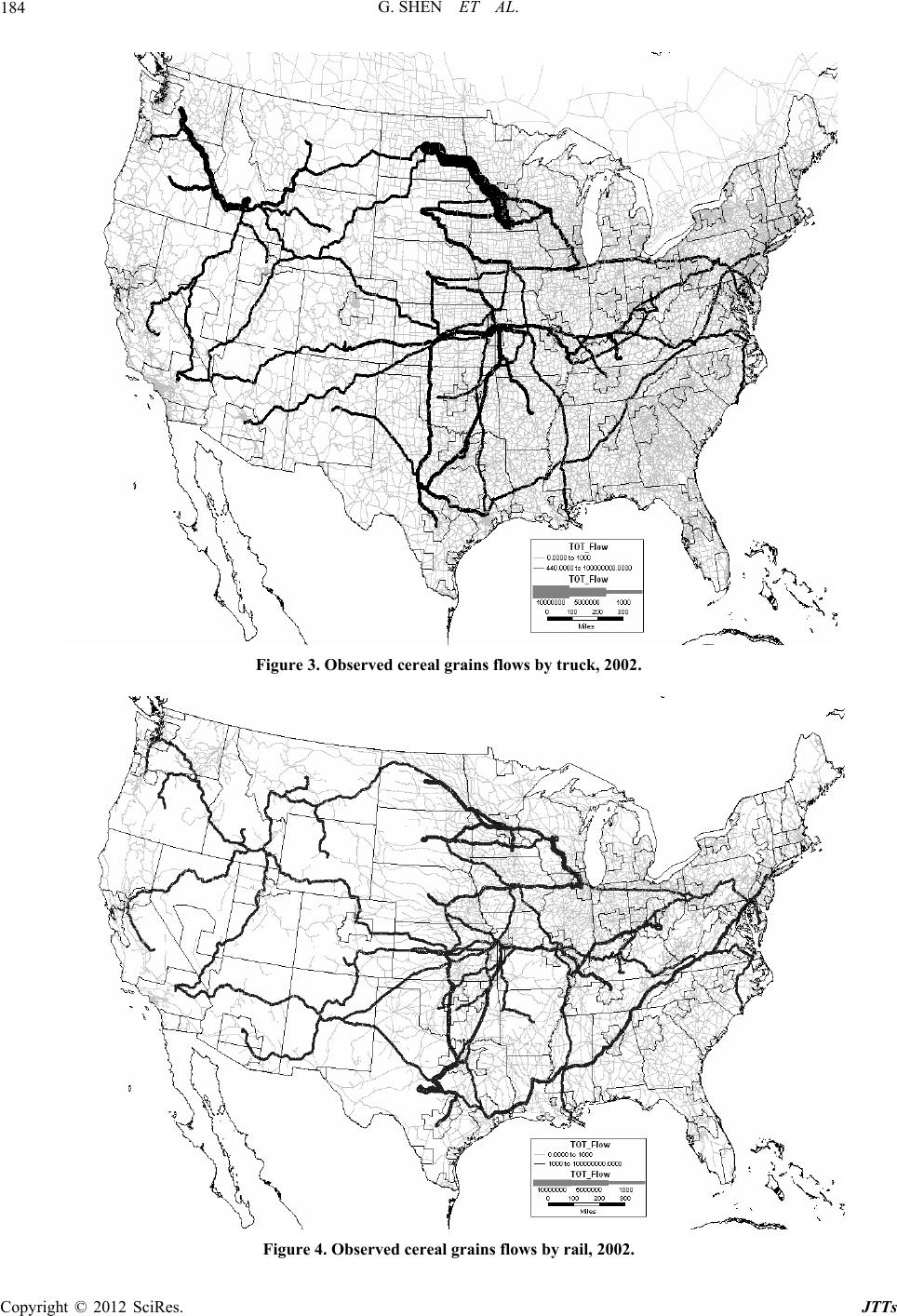 G. SHEN ET AL. Copyright © 2012 SciRes. JTTs 184 Fig Obserereal grainsy tr20 ure 3.ved c flows buck, 02. Figure 4. Observed cereal grains flows by rail, 2002. 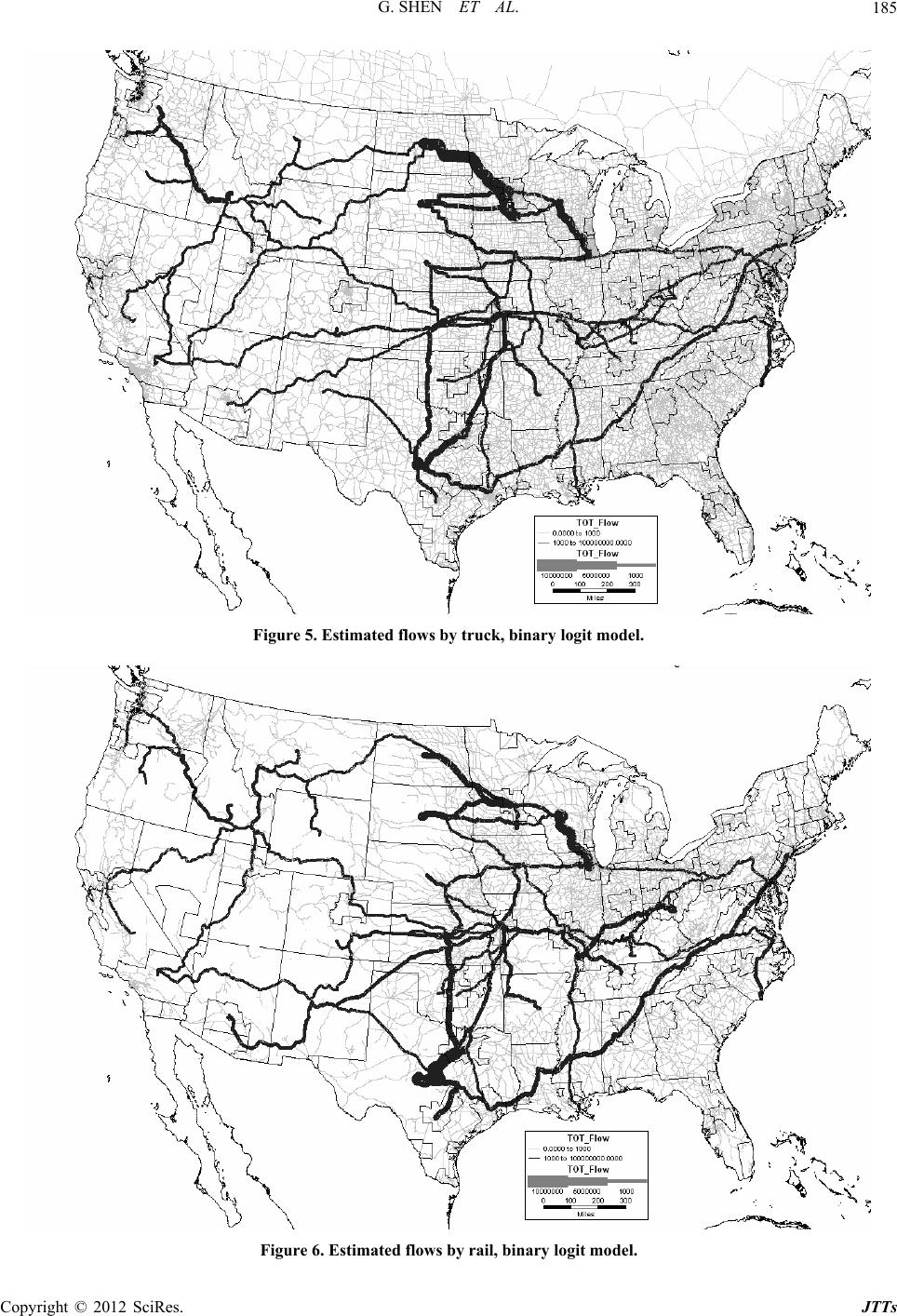 G. SHEN ET AL. 185 Figure 5. Estimated flows by truck, binary logit model. Figure 6. Estimated flows by rail, binary logit model. Copyright © 2012 SciRes. JTTs 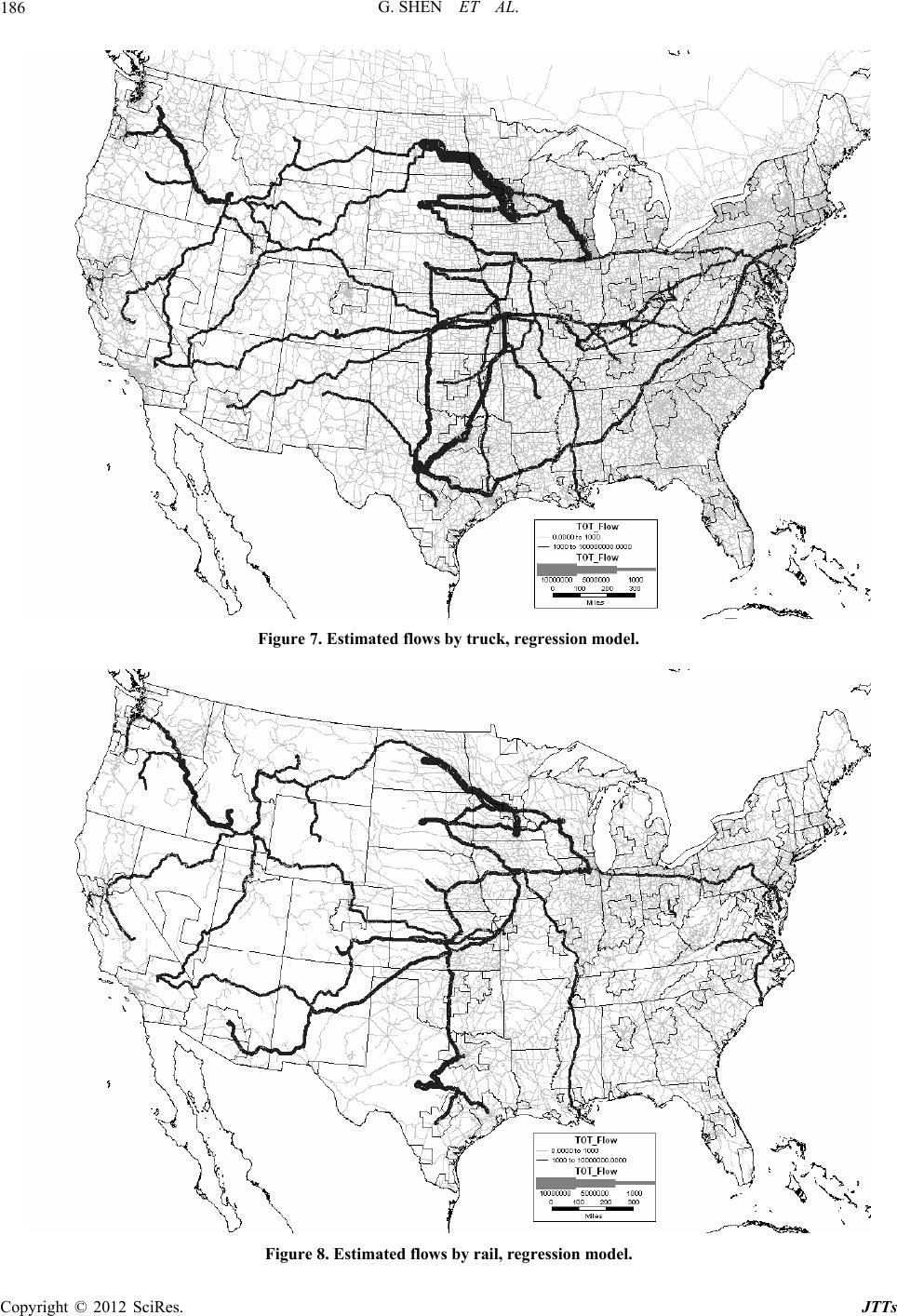 G. SHEN ET AL. 186 Figure 7. Estimated flows by truck, regression model. Figure 8. Estimated flows by rail, regression model. Copyright © 2012 SciRes. JTTs 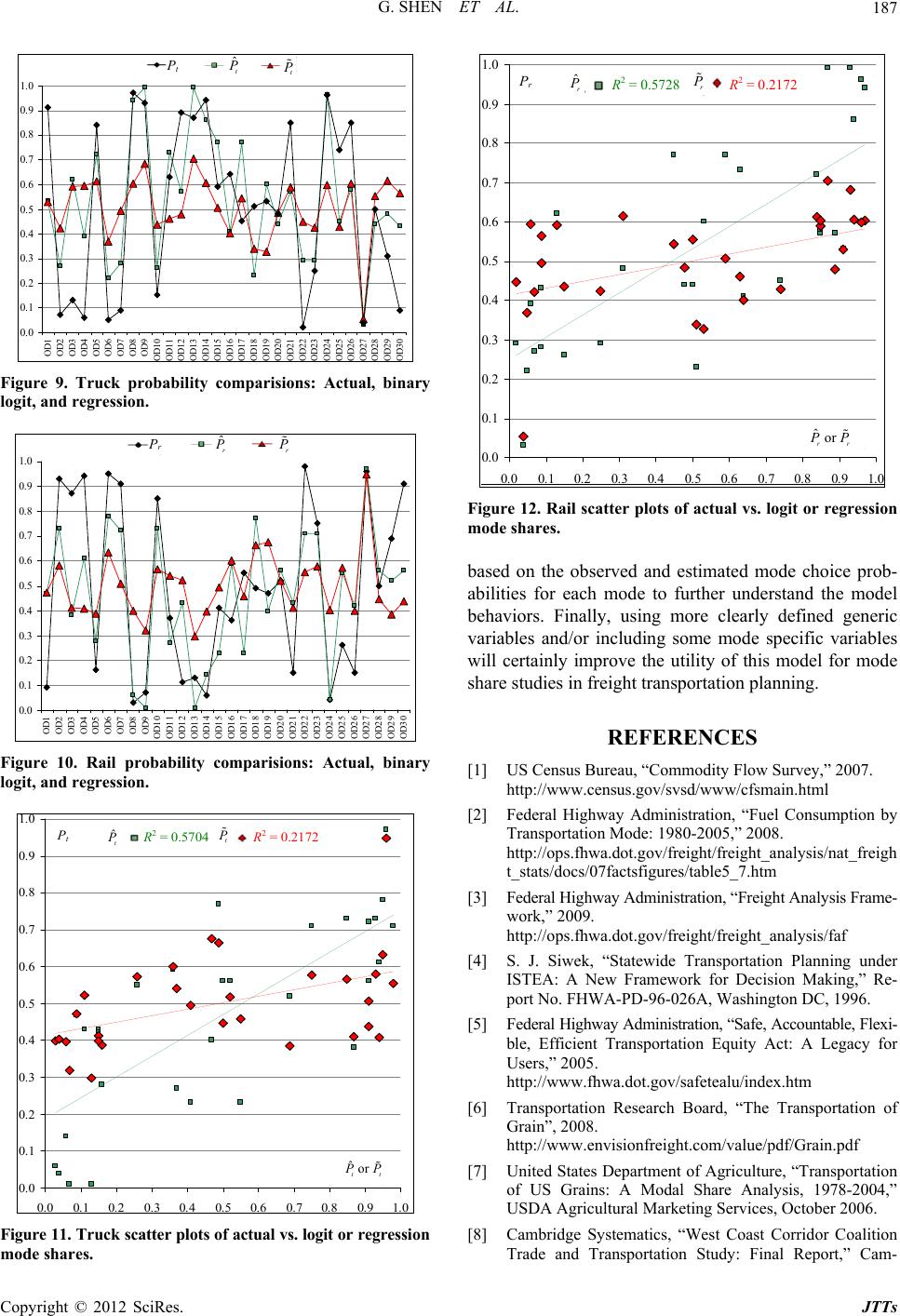 G. SHEN ET AL. Copyright © 2012 SciRes. JTTs 187 0. 0 0. 1 0. 2 0. 3 0. 4 0. 5 0. 6 0. 7 0. 8 0. 9 1. 0 OD1 OD2 OD3 OD4 OD5 OD6 OD7 OD8 OD9 O D10 O D11 O D12 O D13 O D14 O D15 O D16 O D17 O D18 O D19 O D20 O D21 O D22 O D23 O D24 O D25 O D26 O D27 O D28 O D29 O D30 系列2系列3系列1 ˆt P P t t P 0. 0 0. 1 0. 2 0. 3 0. 4 0. 5 0. 6 0. 7 0. 8 0. 9 1. 0 0. 0 0. 1 0. 2 0.3 0. 4 0.5 0. 6 0. 7 0. 8 0. 9 1 .0 ˆr P P r R 2 = 0.57 28 R 2 = 0.21 72 ˆor rr P P r P Figure 9. Truck probability comparisions: Actual, binary logit, and regression. 0. 0 0. 1 0. 2 0. 3 0. 4 0. 5 0. 6 0. 7 0. 8 0. 9 1. 0 OD1 OD2 OD3 OD4 OD5 OD6 OD7 OD8 OD9 OD1 0 OD1 1 OD1 2 OD1 3 OD1 4 OD1 5 OD1 6 OD1 7 OD1 8 OD1 9 OD2 0 OD2 1 OD2 2 OD2 3 OD2 4 OD2 5 OD2 6 OD2 7 OD2 8 OD2 9 OD3 0 系列 1 系列 2 系列 3 ˆr P P r r P Figure 12. Rail scatter plots of actual vs. logit or regression mode shares. based on the observed and estimated mode choice prob- abilities for each mode to further understand the model behaviors. Finally, using more clearly defined generic ng some mode specific variables will certainly improve the utility of this model for mode share studies in freight transportation planning. REFERENCES [1] US Census Bureau, “Commodity Flow Survey,” 2007. http://www.census.gov/svsd/www/cfsmain.html [2] Federal Highway Administration, “Fuel Consumption by Transportation Mode: 1980-2005,” 2008. http://ops.fhwa.dot.gov/freight/freight_analysis/nat_freigh t_stats/docs/07factsfigures/table5_7.htm [3] Federal Highway Administration, “Freight Analysis Frame- work,” 2009. http://ops.fhwa.dot.gov/freight/freight_analysis/faf [4] S. J. Siwek, “Statewide Transportation Planning under ISTEA: A New Framework for Decision Making,” Re- port No. FHWA-PD-96-026A, Washington DC, 1996. [5] Federal Highway Administration, “Safe, Accountable, Flexi- ble, Efficient Transportation Equity Act: A Legacy for Users,” 2005. http://www.fhwa.dot.gov/safetealu/index.htm [6] Transportation Research Board, “The Transportation of Grain”, 2008. http://www.envisionfreight.com/value/pdf/Grain.pdf [7] United States Department of Agriculture, “Transportation of US Grains: A Modal Share Analysis, 1978-2004,” USDA Agricultural Marketing Services, October 2006. [8] Cambridge Systematics, “West Coast Corridor Coal rtation Study: Final Report,” Cam- variables and/or includi Figure 10. Rail probability comparisions: Actual, binary logit, and regression. 0. 0 0. 1 0. 2 0. 3 0. 4 0. 5 0. 6 0. 7 0. 8 0. 9 1. 0 0.00.1 0.20.3 0.40.5 0.60.7 0.80.9 1.0 系列1系列2 ˆt P P t t P R 2 = 0.5704 R 2 = 0.2172 ˆor tt PP ition Figure 11. Truck scatter pl ots of actual v s. logit or regressi on mode shares. Trade and Transpo 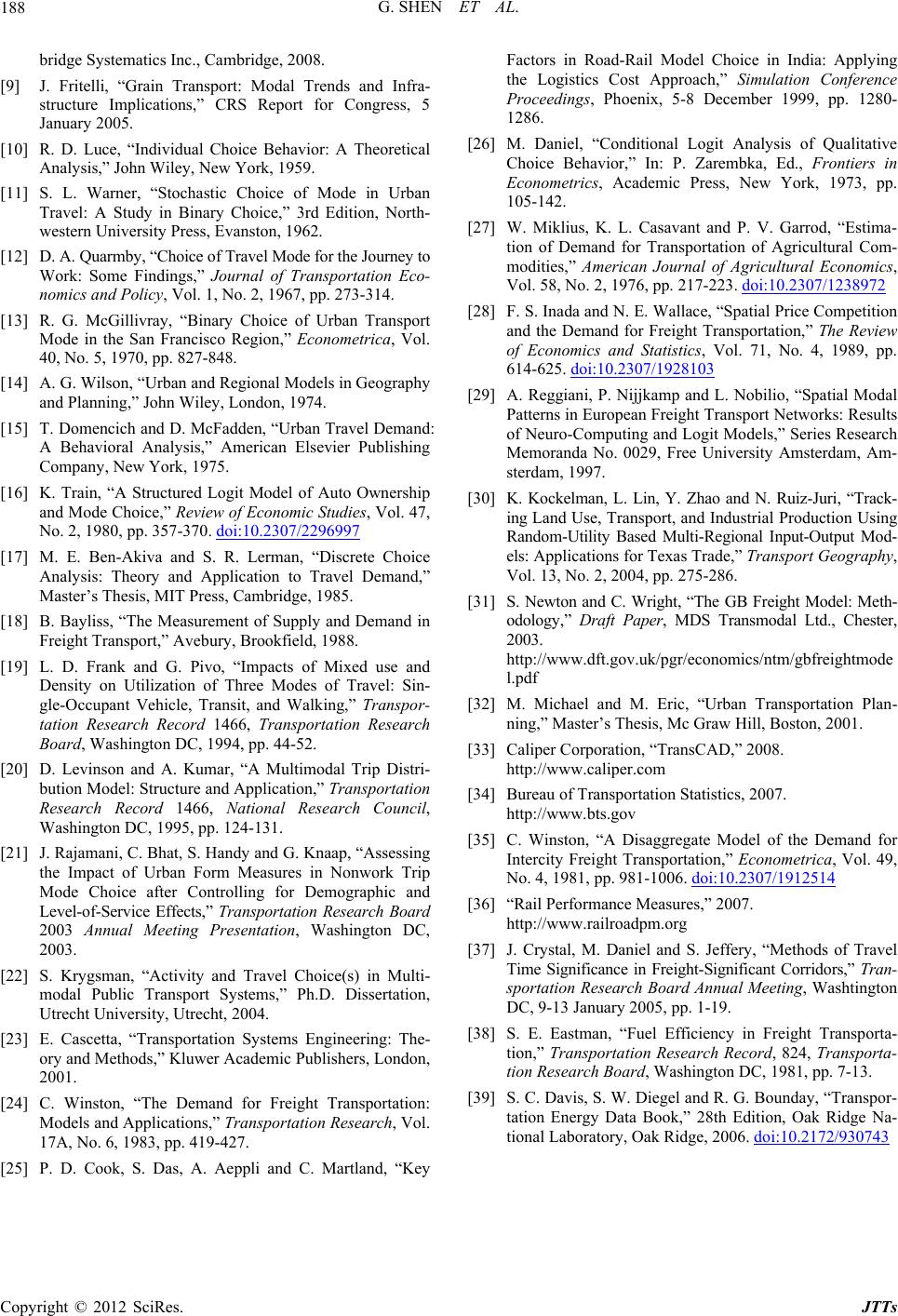 G. SHEN ET AL. 188 bridge Systematics Inc., Cambridge, 2008. [9] J. Fritelli, “Grain Transport: Modal Trends and Infra- structure Implications,” CRS Report for Congress, 5 January 2005. [10] R. D. Luce, “Individual Choice Behavior: A Theoretical Analysis,” John Wiley, New York, 1959. [11] S. L. Warner, “Stochastic Choice of Mode in Urban Travel: A Study in Binary Choice,” 3rd Edition, North- western University Press, Evanston, 1962. [12] D. A. Quarmby, “Choice of Travel Mode for the Journey to Work: Some Findings,” Journal of Transportation Eco- nomics and Policy, Vol. 1, No. 2, 1967, pp. 273-314. [13] R. G. McGillivray, “Binary Choice of Urban Transport Mode in the San Francisco Region,” Econometrica, Vol. 40, No. 5, 1970, pp. 827-848. hn Wiley, London, 1974. 5] T. Domencich and D. McFadden, “Urban Travel Demand: A Behavioral Analysis,” American Elsevier Publishing Company, New York, 1975. [16] K. Train, “A Structured Logit Model of Auto Ownership and Mode Choice,” Review of Economic Studies, Vol. 47, No. 2, 1980, pp. 357-370. doi:10.2307/2296997 [14] A. G. Wilson, “Urban and Regional Models in Geography and Planning,” Jo [1 [17] M. E. Ben-Akiva and S. R. Lerman, “Discrete Choice Analysis: Theory and Application to Travel Demand,” Master’s Thesis, MIT Press, Cambridge, 1985. [18] B. Bayliss, “The Measurement of Supply and Demand in Freight Transport,” Avebury, Brookfield, 1988. [19] L. D. Frank and G. Pivo, “Impacts of Mixed use and Density on Utilization of Three Modes of Travel: Sin- gle-Occupant Vehicle, Transit, and Walking,” Transpor- tation Research Record 1466, Transportation Research Board, Washington DC, 1994, pp. 44-52. ucture and Application,” Transportation Research Record 1466, National Research Council Washington DC, 1995, pp. 124 [21] J. Rajamani, C. Bhat, S. Handy and G. Knaap, “Assessing the Impact of Urban Form Measures in Nonwork Trip Mode Choice after Controlling for Demographic Level-of-Service Effects,” Transportation Research Board 2003 Annual Meeting Presentation, Washington DC, 2003. [22] S. Krygsman, “Activity and Travel Choice(s) in Multi- modal Public Transport Systems,” Ph.D. Dissertation, Utrecht University, Utrecht, 2004. [23] E. Cascetta, “Transportation Systems Engineering: Th ory and Methods,” Kluwer Academic Publishers, London, 2001. [24] C. Winston, “The Demand for Freight Transportation Models and Applications,” Transportation Research, Vol 17A, No. 6, 1983, pp. 419-427. [25] P. D. Cook, S. Das, A. Aeppli and C. Martland, “Key Factors in Road-Rail Model Choice in India: Applying the Logistics Cost Approach,” Conference Proceedings, Phoenix, 5-8 December 1999, pp. 1280- 1286. [26] M. Daniel, “Conditional Logit Analysis of Qualitative Choice Behavior,” In: P. Zarembka, Ed., Frontiers in Econometrics, Academic Press, New York, 1973, pp. 105-142. [27] W. Miklius, K. L. Casavant and P. V. Garrod, “Estima- tion of Demand for Transportation of Agricultural Com- modities,” American Journal of Agricultural Economics, Vol. 58, No. 2, 1976, pp. 217-223. doi:10.2307/1238972 [20] D. Levinson and A. Kumar, “A Multimodal Trip Distri- bution Model: Str, -131. Simulation [28] F. S. Inada and N. E. Wallace, “Spatial Price Competition and the Demand for Freight Transportation,” The Review of Economics and Statistics, Vol. 71, No. 4, 1989, pp. 614-625. doi:10.2307/1928103 [29] A. Reggiani, P. Nijjkamp and L. Nobilio, “Spatial Modal Patterns in European Freight Transport Networks: Results of Neuro-Computing and Logit Models,” Series Research Memoranda No. 0029, Free University Amsterdam, Am- sterdam, 1997. tility Based Multi-Regional Input-Output Mod- [32] M. Michael and M. Eric, “Urban Transportation Plan- ning,” Master’Boston, 2001. [33] Caliper Corpor8. 2514 and e- : . [30] K. Kockelman, L. Lin, Y. Zhao and N. Ruiz-Juri, “Track- ing Land Use, Transport, and Industrial Production Using Random-U els: Applications for Texas Trade,” Transport Geography, Vol. 13, No. 2, 2004, pp. 275-286. [31] S. Newton and C. Wright, “The GB Freight Model: Meth- odology,” Draft Paper, MDS Transmodal Ltd., Chester, 2003. http://www.dft.gov.uk/pgr/economics/ntm/gbfreightmode l.pdf s Thesis, Mc Graw Hill, ation, “TransCAD,” 200 http://www.caliper.com [34] Bureau of Transportation Statistics, 2007. http://www.bts.gov [35] C. Winston, “A Disaggregate Model of the Demand for Intercity Freight Transportation,” Econometrica, Vol. 49, No. 4, 1981, pp. 981-1006. doi:10.2307/191 7-13. 3 [36] “Rail Performance Measures,” 2007. http://www.railroadpm.org [37] J. Crystal, M. Daniel and S. Jeffery, “Methods of Travel Time Significance in Freight-Significant Corridors,” Tran- sportation Research Board Annual Meeting, Washtington DC, 9-13 January 2005, pp. 1-19. [38] S. E. Eastman, “Fuel Efficiency in Freight Transporta- tion,” Transportation Research Record, 824, Transporta- tion Research Board, Washington DC, 1981, pp. [39] S. C. Davis, S. W. Diegel and R. G. Bounday, “Transpor- tation Energy Data Book,” 28th Edition, Oak Ridge Na- tional Laboratory, Oak Ridge, 2006. doi:10.2172/93074 Copyright © 2012 SciRes. JTTs |

